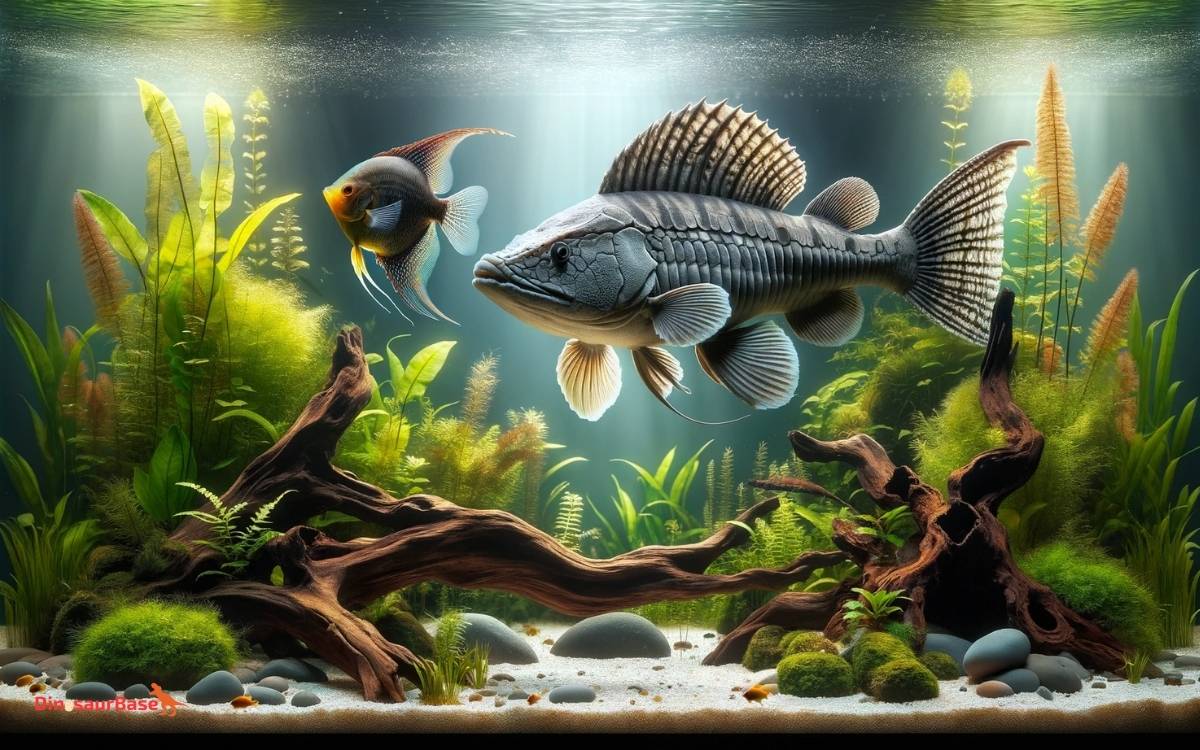Can Dinosaur Bichir Live With Angelfish: True or Myth?
Dinosaur bichir and angelfish typically have different care requirements. Co-habituation is risky due to potential aggression and varying environmental needs.
Keeping diverse species in an aquarium appeals to many aquarists who seek to create a dynamic environment.
The idea of housing the prehistoric-looking dinosaur bichir with the elegant angelfish is intriguing. However, a successful mixed-species tank requires knowledge about compatibility.
Dinosaur bichir, a carnivorous species, might view smaller fish as prey, and angelfish, with their trailing fins, can be tempting targets.
Aquarists should consider the various aspects of care, diet, and behavior before attempting such a combination.
Water parameters, such as temperature and pH, also play a critical role. Each species thrives under specific conditions, and maintaining a balance that suits both can be challenging.
Hence, careful consideration and expert advice is essential when determining if these distinct fish can share a habitat without stress.

Introduction To Dinosaur Bichir And Angelfish
Welcome to the underwater realm where prehistoric meets elegance. Here, we dive into the worlds of the Dinosaur Bichir, a throwback from ancient times, and the Angelfish, a staple of beauty in aquascapes worldwide.
This introduction brings you closer to understanding these fascinating creatures and whether they can share a home beneath the water’s surface.
Distinctive Traits Of Dinosaur Bichir
- Origin: Nile River and Congo Basin in Africa.
- Appearance: Elongated body, snake-like appearance.
- Size: Can grow up to 18 inches.
- Behavior: Bottom-dwelling, nocturnal predators.
Characteristics Of Angelfish
- Natural Habitat: Amazon Basin in South America.
- Form: Triangular body, long fins.
- Color Varieties: Wide range including silvers, blacks and golds.
- Temperament: Peaceful but can be territorial.
Aquarium Compatibility: Key Considerations
| Factor | Dinosaur Bichir | Angelfish |
|---|---|---|
| Water Parameters | Warm, slightly acidic to neutral pH | Warm, slightly acidic to neutral pH |
| Space Needs | Large tank for ample swimming | Tall tank for fin growth |
| Diet | Carnivorous, live or frozen prey | Omnivorous, flake and live foods |
| Social Behavior | Solitary or with large fish | Groups or with peaceful fish |
Natural Habitats And Requirements
Understanding the natural habitats and requirements of different fish species is crucial for a harmonious aquarium. Fish from varying environments have unique needs, often making them incompatible.
Today, let’s explore whether the prehistoric-looking Dinosaur Bichir can share a tank with the majestic Angelfish.
Dinosaur Bichir’s Native Environment
Dinosaur Bichirs, or Polypterus senegalus, hail from Africa’s freshwater rivers. They thrive in slow-moving waters, often murky and filled with plants. These nocturnal predators enjoy soft substrates where they can scour for food.
- Native to Nile, Congo, and Niger Rivers
- Prefer slow-moving, vegetated waters
- Enjoy a muddy or sandy bottom
Angelfish In The Amazon Basin
Conversely, Angelfish originate from the Amazon Basin. Their world is one of warm, acidic waters, densely populated with foliage and tree roots. These elegant swimmers need space to spread their tall fins. A vertical tank height is essential.
- Warm, acidic water conditions
- Lush plant life and tree roots
- Require vertical space for fin growth
Impact Of Water Parameters On Cohabitation
Water parameters are key for fish cohabitation. Both species need similar temperatures. Dinosaur Bichirs prefer slightly cooler waters than Angelfish, yet there’s a common range where both can survive.
The pH and hardness levels for each vary, potentially causing stress if not managed properly.
| Parameter | Dinosaur Bichir | Angelfish |
|---|---|---|
| Temperature | 22-28°C (72-82°F) | 24-30°C (75-86°F) |
| pH Level | 6.5-7.5 | 6.0-7.0 |
| Water Hardness | 5-19 dGH | 3-8 dGH |
Creating a tank that mimics the native habitats of both species with a focus on these parameters can help ensure a peaceful coexistence.
Behavioral Patterns Explained
Welcome to a deep dive into the cohabitation quirks between Dinosaur Bichir and Angelfish. Understanding these fish behavior patterns is key to a peaceful tank.
Territorial Nature Of Both Species
Dinosaur Bichirs and Angelfish guard their space keenly. Bichirs roam the bottom, while Angelfish prefer the top and mid-sections. They need separate zones to flourish.
Feeding Behaviors That May Conflict
Bichirs are nocturnal predators with a hearty appetite. Angelfish feed during the day.
- Bichirs might outcompete Angelfish for food.
- Both species require specific diets.
Social Dynamics In A Shared Space
Both fish can show aggression if not given enough room. Bichirs grow larger and can stress Angelfish if they invade their space.
| Dinosaur Bichir | Angelfish |
|---|---|
| Prefers solitude at the bottom | Needs open water to swim |
| Can be aggressive to smaller fish | Sensitive to stress |
Case Studies And Aquarium Success Stories
Dinosaur Bichir and Angelfish appear to be from entirely different prehistoric epochs, yet aquarium hobbyists explore the possibilities of companionship between the two.
Success stories in the world of aquatic cohabitation shed light on the feasibility, challenges, and careful orchestration behind such endeavors. Curated case studies guide enthusiasts through the journey of pairing these fascinating species.
Instances Of Dinosaur Bichir And Angelfish Cohabitation
Fish lovers frequently report instances of peaceful coexistence between Dinosaur Bichirs and Angelfish.
Evidence shows success in larger tanks with proper hiding spots and ample space. This allows the Angelfish to swim freely without encroaching on the Bichir’s domain.
- A 100-gallon tank housing both species with no reported incidences.
- Stories from a community aquarium where both fish thrive in harmony.
Challenges In Real-life Scenarios
Not all attempts at cohabitation are successful. Common challenges include territorial behavior and size disparity. Smaller Angelfish may fall prey to Bichirs if not monitored closely.
| Challenge | Outcome |
|---|---|
| Size Disparity | Necessitates vigilant stock monitoring |
| Food Competition | May lead to nutritional deficiencies |
| Aggression | Requires strategic habitat structuring |
Expert Aquarist Testimonials
“I’ve seen both species cohabitate peacefully. It’s about understanding and catering to their unique needs.”
– Jane Doe, Senior Aquarist
“It’s possible, but the key is a spacious tank with plenty of hideouts to prevent stress.”
– John Smith, Fish Behaviorist
Testimonials highlight that expert guidance and experienced insight are crucial. This ensures every aquatic pet lives a full, healthy life in a shared environment.
Keeping Peace In The Tank
Creating a calm community tank with Dinosaur Bichirs and Angelfish is like setting up a neighborhood where everyone gets along. It’s not just about tossing them together and hoping for the best. Special attention is crucial to maintain peace.
Tank Size And Setup For Harmony
The key to harmony starts with space. A spacious tank allows each fish to claim its own territory. Ideally, aim for a minimum of 75 gallons—the larger, the better.
Proper tank setup means ample hiding spots, like caves and plants, to provide refuge and comfort.
- Large tank size minimizes stress and competition.
- Multiple hiding spots allow for natural behaviors.
- Variety in the environment keeps fish engaged and away from conflicts.
Diet Considerations To Reduce Aggression
A well-fed fish is a peaceful one. Both species have different diets, so tailored feeding prevents competition. Angelfish prefer flake foods and live food sometimes, while Bichirs are carnivorous.
| Fish | Preferred Diet |
|---|---|
| Angelfish | Flakes, live foods |
| Bichir | Carnivorous, sinking foods |
Feeding at different tank levels can prevent conflicts over food.
Monitoring And Intervening In Conflicts
Watch your fish’s behavior closely. Intervening quickly when aggression occurs is vital for a peaceful tank. Separation or rearrangement of the tank might be necessary if conflicts persist.
- Regular observation helps identify signs of stress early.
- Quick intervention can prevent injuries.
- Adjustment of tank setup may be needed to maintain peace.
Myths Vs. Facts On Aquatic Cohabitation
Fish enthusiasts often wonder if Dinosaur Bichir and Angelfish can live together peacefully. Aquarium cohabitation can be complex. It’s vital to separate myths from facts. Let’s explore the truth about these species sharing a tank.
Debunking Common Myths
- Myth: All fish get along if the tank is large enough.
- Fact: Size matters but so do species’ needs and behaviors.
- Myth: Predator and prey fish can coexist with proper hiding spaces.
- Fact: Predatory instincts can override environmental factors.
Evidence-based Compatibility Insights
When considering Bichir and Angelfish together, observe these facts:
- Dinosaur Bichir are nocturnal hunters. They may see Angelfish as prey.
- Angelfish require calm waters. Bichirs’ movement might stress them.
An ideal tank setting considers both species’ needs to minimize stress.
Resources For Responsible Fishkeeping
For successful fishkeeping, use these resources:
- Fish behavior guides: Understand species-specific habits.
- Aquarium condition trackers: Monitor water quality and space.
- Expert forums: Seek advice from experienced aquarists.
Knowledge and preparation ensure a thriving aquatic environment. Choose tank mates wisely.
Frequently Asked Questions Of Can Dinosaur Bichir Live With Angelfish
What Fish Get Along With Bichirs?
Bichirs generally coexist well with larger, peaceful fish. Compatible tank mates include Oscars, Knifefish, and certain large Cichlids. Avoid pairing them with small fish, as they may become prey.
Will Bichir Eat My Fish?
Bichirs can eat smaller fish, so it’s essential to only house them with fish of similar size to avoid predation. Always monitor tank interactions to ensure safety.
Are Bichirs Aggressive?
Bichirs can display territorial aggression, particularly during feeding or when housed in cramped conditions. Providing ample space and hiding spots can minimize aggressive behavior.
Can I Keep Bichir With Flowerhorn?
Keeping bichirs with Flowerhorns is not recommended. Flowerhorns can be aggressive and may harm the slower, more docile bichirs. Select tank mates carefully to ensure compatibility and safety.
Conclusion
Balancing the needs of Bichir and Angelfish can be tricky. Successful cohabitation depends on tank size, plant coverage, and careful monitoring.
Always prioritize the well-being of your aquatic companions when mixing species. With the right environment and attentive care, your fish may thrive together in an aquatic harmony.





